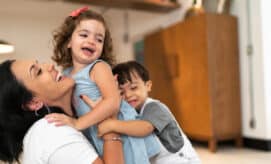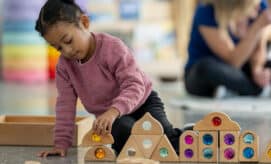As educators and caregivers, an important part of our work is building relationships with children. Children thrive in environments where they feel loved, valued, and safe. CSEFEL shares that ”teacher-child relationships play a significant role in influencing young children’s social and emotional development. In studies of teacher-child relationships, children who had a secure relationship with their preschool and kindergarten teachers demonstrated good peer interactions and positive relationships with teachers and peers in elementary school.”
Every interaction with children is an opportunity to build relationships. By taking time to reflect on the way that we interact, communicate, and connect with young children, we are able to become more thoughtful and intentional, ultimately creating a classroom environment that supports learning and development. To help guide your reflections on this important practice, you will find tips and suggestions for thoughtful interactions with children below.
Listen to, Acknowledge, and Support Children’s Feelings
Children have and will express a wide range of emotions, and it is important that these feelings are acknowledged and accepted. Understanding children’s emotions starts with listening. When children talk to you, get down on their level, and listen to what they have to say. Let them finish their thought before you respond, so that they know that you care. If you are busy, or unable to listen to a child in a particular moment, let them know that you will listen when you are free, “I’m talking to Sam right now, but as soon as we’re finished, I’d like to hear what you have to say.”
SFSU Children’s Center notes that the educator or caregiver’s role is to support children as they process emotions by comforting, identifying, reflecting and validating their emotions. Rather than telling a child that they will be okay, let them work through their own emotional cycle by acknowledging what they are going through, “It’s hard to say goodbye to mom when she leaves”
Step Back when Possible
One of the best ways for children to learn that they are capable and competent is by letting them complete tasks on their own. When you see a child struggling to put two legos together or write their name, give them space to see if they can work out the problem on their own. While we should stay close to children to ensure that they are safe, we often do not need to be so close that they feel crowded. When we take a step back and give children extra room to explore independently, it tells them that we trust their abilities to be successful on their own.
Follow the Child’s Lead
To create a successful curriculum with rich learning opportunities, follow the lead of the children and their play. Interact with the children, talk with them about what they are doing, and ask open-ended questions. Some questions you might ask include, “What are you working on?” “How are you going to make this work?” “Who is in this picture?” “What do you think will happen if we move this block?”
When you take part in children’s learning and follow their lead, you will gain a better understanding of what their interests are and what they are learning. This will help you to create an engaging curriculum by building on these individual interests.





